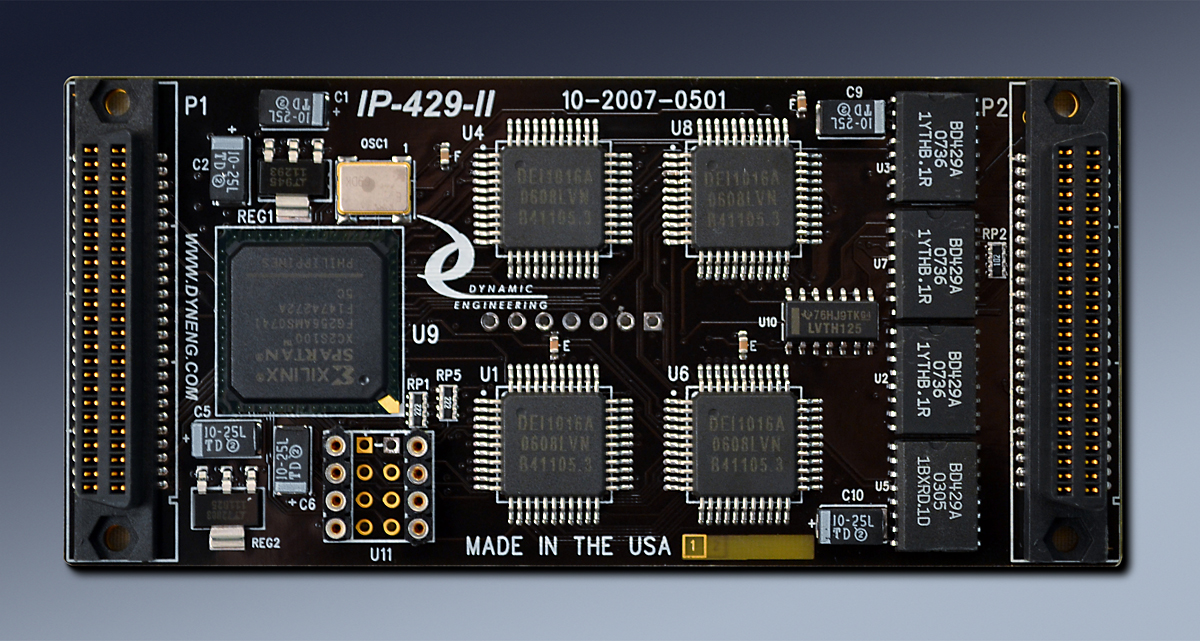IP-CARA
CARA interface
IP-CARA Description
- Windows®, Linux driver included with purchase.
- 8/32 MHz operation
- Can be installed in any IP slot
- Independent transmitter and receiver
- 1 year warranty standard. Extended warranty available.
- Extended [Industrial] Temperature standard.
- ROHS and Standard processing available
The IndustryPack® compatible IP-CARA design integrates the CARA interface onto an IndustryPack module. IP-CARA was previously built on the IP-QuadUART fab. With the new revision of IP-429 the CARA function replaces the 429 standard implementation using the ARINC 429 IO. The VHDL in the FPGA is designed to support the CARA interface. The basic interface is 24 bit serial, LSB first, ARINC 429 levels, HI-Z between words sent. Added features include programmable transmit rate, programmable edge rate, programmable delay between words sent, programmable interrupts. Full Duplex operation with independent receiver and transmitter. Use the IP-CARA module along with a carrier to form a complete solution. Windows® and Linux generic module suppport on any Dynamic Engineering Carrier.

IP-CARA Bit Timing
The interface is memory based with two 1k x 16 FIFOs to support the transmitter and receiver. The data stream is 24 bits per word. The lower data is loaded first then the upper data for each word to be sent. When the IP-CARA is mounted to a carrier which supports 32 bit operations the option for constant address can be used to allow the full 24 bits to be loaded into the FIFO on each write.
IP-CARA is compatible with 8 and 32 MHz IP bus interfaces.
PCIe implementations can be done with the PCIe3IP and PCIe5IP. Applications from 1 to 5 CARA IF per PCIe slot.
PCI implementations can be done with the PCI3IP and PCI5IP. Applications from 1 to 5 CARA IF per PCI slot.
cPCI 3U is supported with the cPCI2IP. Applications for 1 or 2 CARA IF per 3U cPCI slot.
cPCI 6U is supported with the cPCI4IP. Applications from 1 to 4 CARA IF per 6U cPCI slot.
PC104p is supported with the PC104pIP. Applications with 1 CARA IF per PC104 stack position.
PC104p situations with a custom mechanical can be done with the PC104p4IP. Channel counts from 1 to 4 CARA IF per PC104 stack position.
3U VPX is supported with the VPX2IP. Applications with 1 or 2 CARA IF per 3U VPX slot.
The CARA IO is available at the IO connector. Most IP carriers route the IP module IO connectors to 50 pin headers to support ribbon cable. The HDRterm50 can be used to create a terminal block interface. A transition module or custom cables can be designed to support your requirement.
The local oscillator [32 MHz] is used to provide a programmable TX rate, and to capture the received data. The receive side is "auto-baud". The transmit side is programmed with software.


IP-CARA Bit Timing
The interface is memory based with two 1k x 16 FIFOs to support the transmitter and receiver. The data stream is 24 bits per word. The lower data is loaded first then the upper data for each word to be sent. When the IP-CARA is mounted to a carrier which supports 32 bit operations the option for constant address can be used to allow the full 24 bits to be loaded into the FIFO on each write.
IP-CARA is compatible with 8 and 32 MHz IP bus interfaces.
PCIe implementations can be done with the PCIe3IP and PCIe5IP. Applications from 1 to 5 CARA IF per PCIe slot.
PCI implementations can be done with the PCI3IP and PCI5IP. Applications from 1 to 5 CARA IF per PCI slot.
cPCI 3U is supported with the cPCI2IP. Applications for 1 or 2 CARA IF per 3U cPCI slot.
cPCI 6U is supported with the cPCI4IP. Applications from 1 to 4 CARA IF per 6U cPCI slot.
PC104p is supported with the PC104pIP. Applications with 1 CARA IF per PC104 stack position.
PC104p situations with a custom mechanical can be done with the PC104p4IP. Channel counts from 1 to 4 CARA IF per PC104 stack position.
3U VPX is supported with the VPX2IP. Applications with 1 or 2 CARA IF per 3U VPX slot.
The CARA IO is available at the IO connector. Most IP carriers route the IP module IO connectors to 50 pin headers to support ribbon cable. The HDRterm50 can be used to create a terminal block interface. A transition module or custom cables can be designed to support your requirement.
The local oscillator [32 MHz] is used to provide a programmable TX rate, and to capture the received data. The receive side is "auto-baud". The transmit side is programmed with software.

IP-CARA Features
Size
Standard Type 1 IndustryPack® Module.
CARA Channels
Independed TX and RX channels are provided.
Interface
ARINC 429 IO levels are used.
Speed
Programmable TX rates at the typical ARINC 429 values [10-15 or 100 KHz]. Higher than standard can also be used up to 1M.
Bus Operation
TX drivers remain tristated except when transmitting.
Termination
Each side of the TX signals [A&B] are coupled with 37.5 Ohms in series to meet the 75 Ohm impedence requirement.
Clocks
8 and 32 MHz operation IP Module bus operation.
Access Width
ID PROM is byte wide, internal control register is word wide, FIFOs are word wide.
ID PROM
The IDPROM is built into the Xilinx. The PROM contents are available to determine the current revision of the IP-CARA and to determine the slot location. The user manual has the expected data content definition.
Software Interface
Control registers are read-writeable IO, ID, INT spaces supported. Windows® and Linux support on Dynamic Engineering carriers.
Interrupts
Interrupt level 0 is used to route the CARA interrupt to the host computer. The interrupt is maskable and pollable.
Power Requirement
+5V, +12, -12
Oscillator
One 32 MHz Oscillator is provided to cover the full frequency range and extended operations. The oscillator frequency can be changed upon request. Custom versions with special frequency requirements can be supported.
IP-CARA Benefits
Speed
The IP-CARA is compatible with 8 and 32 MHz IP reference rates with FIFO memory capability. Use with Dynamic Engineering carriers for maximum throughput. Standard and customer specified transmit rates are software programmable.
Ease of Use
IP-CARA is easy to use. A point and shoot user interface to or from the IO. The engineering kit provides a good starting point for a new user. The reference software does a loop-back test and sets-up the different modes of operation.
Availability
IP-CARA is an unusual combination of trianary logic with custom serial definition. The design can be further customized for your requirements. We work to keep the IP-QuadUART in stock. We keep limited numbers of the IP-CARA design available. If you need to customize, Dynamic Engineering can create a new version for you with limited delay.
Size
IP-CARA in standard configuration is a Type 1 size IP module, which conforms to the IndustryPack mechanical and electrical specifications. The IP-CARA can be used in all IP slots.
IP Compatibility
IP-CARA is IP compliant per the VITA 4 - 1995 specification. All Dynamic Engineering IP Modulees are compatible with all Dynamic Engineering IP Carriers. The IP-CARA will operate with any IP specification compliant carrier board.
Part Number: IP-CARA
Ordering Options
- IP-CARA Standard board - CARA interface, Industrial temperature components. Add any of the following build options after the PN as shown below:
- -ROHS Use ROHS processing. Standard processing is "leaded"
- -CC Option to add Conformal Coating
IP-CARA Drivers
Software Support Windows® , and Linux compliant drivers
Please see the Driver manuals for the specifics of each type.
Please see the Driver manuals for the specifics of each type.
IP-CARA Manuals
Download the IP-CARA Manual in PDF format.
Note: Pinout to be updated to match IP-429 design.
Note: Pinout to be updated to match IP-429 design.


